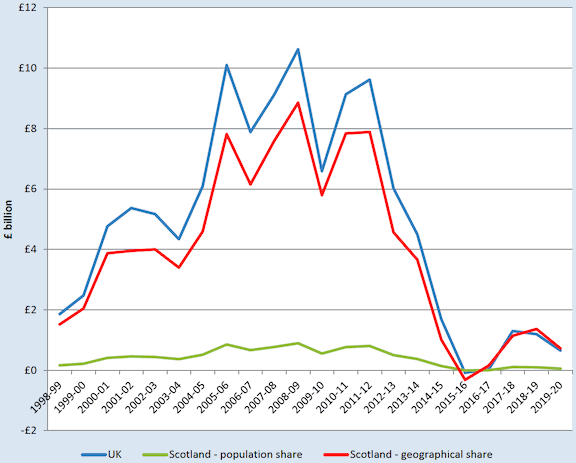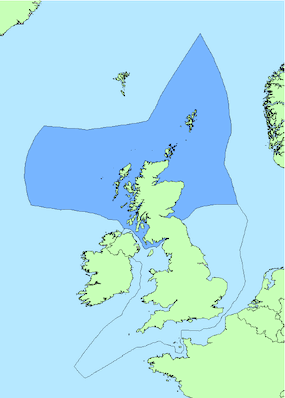Government Expenditure and Revenue Scotland (GERS) 2019-2020
Government Expenditure and Revenue Scotland (GERS) is a National Statistics publication. It estimates the revenue raised in Scotland and the goods and services provided for the benefit of Scotland.
Chapter 2: North Sea Revenue

Introduction
In GERS, the term North Sea is used to refer to all offshore oil and gas activity. North Sea revenue in GERS comes from three sources: petroleum revenue tax, corporation tax, and licence fees.
Table 2.1 shows the revenue raised from each component of North Sea revenue since 2015‑16. UK North Sea revenue was -£85 million in 2015-16, with refunds of petroleum revenue tax exceeding other tax receipts. It has since increased, reaching £1.2 billion in 2018‑19, but fell again in 2019-20.
| £ million | |||||
|---|---|---|---|---|---|
| 2015-16 | 2016-17 | 2017-18 | 2018-19 | 2019-20 | |
| Licence fees | 67 | 67 | 72 | 72 | 72 |
| North Sea corporation tax | 410 | 622 | 1,793 | 1,867 | 990 |
| Petroleum revenue tax | -562 | -653 | -568 | -744 | -412 |
| Total | -85 | 36 | 1,297 | 1,195 | 650 |
North Sea revenue is subject to annual fluctuations and is driven by a number of factors, including the oil price, the sterling dollar exchange rate, production, operating expenditure, capital investment, and the prevailing fiscal regime.
During 2019-20, the oil price averaged $61.4 per barrel. This represents a 12% decline from $70.1 in the previous year. Prices in 2019-20 were extremely volatile, with the daily price ranging between $74.9 and $14.9.[17] This volatility was largely caused by the Covid-19 related oil demand decreases and the resultant oil price fall during Q1 2020.
Overall North Sea production declined slightly in 2019-20, with crude oil and natural gas liquid (NGL) production falling by 1.8%[18] and annual gas production by 0.7%.[19] The slight falls in production during the period can be largely attributed to reduced output at several large gas terminals during 2019, as well as the prolonged shutdown of the Mossmorran NGL processing plant in Fife.
In 2019, total expenditure on the UK Continental Shelf increased by 3.8% in real terms compared to 2018, to stand at £15.02 billion. The increase was primarily due to an increase in exploration and appraisal (E&A) and capital expenditure, which were up 33% and 8% respectively in real terms. Decommissioning expenditure and operating costs decreased slightly by 2% and 0.4% respectively in real terms.[20]
The fiscal regime has been unchanged since in the March 2015 and 2016 Budgets, when the Supplementary Charge was halved to 10%, and Petroleum Revenue Tax (PRT) progressively reduced from 50% to 0%.
As shown in Table 2.1, PRT receipts are now negative. This reflects the fact that, although companies no longer pay PRT, they can still claim refunds on PRT paid in previous years against current trading losses and decommissioning spending. As a result, PRT receipts will only be negative in the future under the current tax regime.
Scotland’s Share of North Sea Revenue
In the ONS Regional Accounts, the UK continental shelf is not allocated to specific geographic regions, but is considered a separate region of the UK (the extra-regio territory). As such, an assumption as to Scotland’s share of the North Sea needs to be made in GERS.
Two estimates of Scotland’s share of North Sea revenue are shown in GERS:
1. A population share
2. An illustrative geographical share
The discussion below focuses on population and geographical shares.
Population Share
One interpretation of North Sea revenue is to view it as a non-identifiable UK revenue, in which case a population share may be apportioned to Scotland. Table 2.2 provides an estimate of Scotland’s share of North Sea revenue under this approach.
| £ million | |||||
|---|---|---|---|---|---|
| 2015-16 | 2016-17 | 2017-18 | 2018-19 | 2019-20 | |
| Total North Sea revenue | -85 | 36 | 1,297 | 1,195 | 650 |
| Scotland’s population share | -7 | 3 | 106 | 98 | 53 |
| Scotland’s share of North Sea revenue (%) | 8.2% | 8.2% | 8.2% | 8.2% | 8.2% |
An Illustrative Geographical Share
An alternative approach is to apportion a geographical share of North Sea revenue to Scotland. In order to estimate this share, GERS uses the share reported in the ONS Country and Regional Public Sector Finances publication. The estimate is based on the median line principle as employed in 1999 to determine the boundary between Scotland and the rest of the UK for fishery demarcation purposes. Other alternatives are possible. Production, costs and revenue are allocated on a field by field basis to either the rest of the UK or Scotland using this boundary.
Table 2.3 shows Scotland’s illustrative geographical share of UK North Sea revenue, broken down by licence fees, corporation tax, and petroleum revenue tax. Since 2015-16, Scotland’s illustrative geographical share of North Sea revenues is often estimated to be above 100% or negative. This reflects the fact that the Scotland’s share of petroleum revenue tax, which is currently negative, is lower than its share of corporation tax.
| £ million | |||||
|---|---|---|---|---|---|
| 2015-16 | 2016-17 | 2017-18 | 2018-19 | 2019-20 | |
| UK revenue | -85 | 36 | 1,297 | 1,195 | 650 |
| Licence fees | 67 | 67 | 72 | 72 | 72 |
| North Sea corporation tax | 410 | 622 | 1,793 | 1,867 | 990 |
| Petroleum revenue tax | -562 | -653 | -568 | -744 | -412 |
| Scottish geographical revenue | -318 | 157 | 1,141 | 1,366 | 724 |
| Licence fees | 55 | 63 | 64 | 63 | 63 |
| North Sea corporation tax | 333 | 590 | 1,584 | 1,640 | 871 |
| Petroleum revenue tax | -705 | -496 | -507 | -337 | -210 |
| Scottish share of UK | 373.6% | 436.8% | 88.0% | 114.3% | 111.4% |
| Licence fees | 81.6% | 94.7% | 88.4% | 87.9% | 87.9% |
| North Sea corporation tax | 81.3% | 94.8% | 88.4% | 87.8% | 88.0% |
| Petroleum revenue tax | 125.5% | 76.0% | 89.3% | 45.3% | 51.1% |
Scotland’s estimated geographical share of the North Sea sector, used in this report, is highlighted in the figure below.

Source: Marine Scotland
Contact
Email: Economic.Statistics@gov.scot
There is a problem
Thanks for your feedback